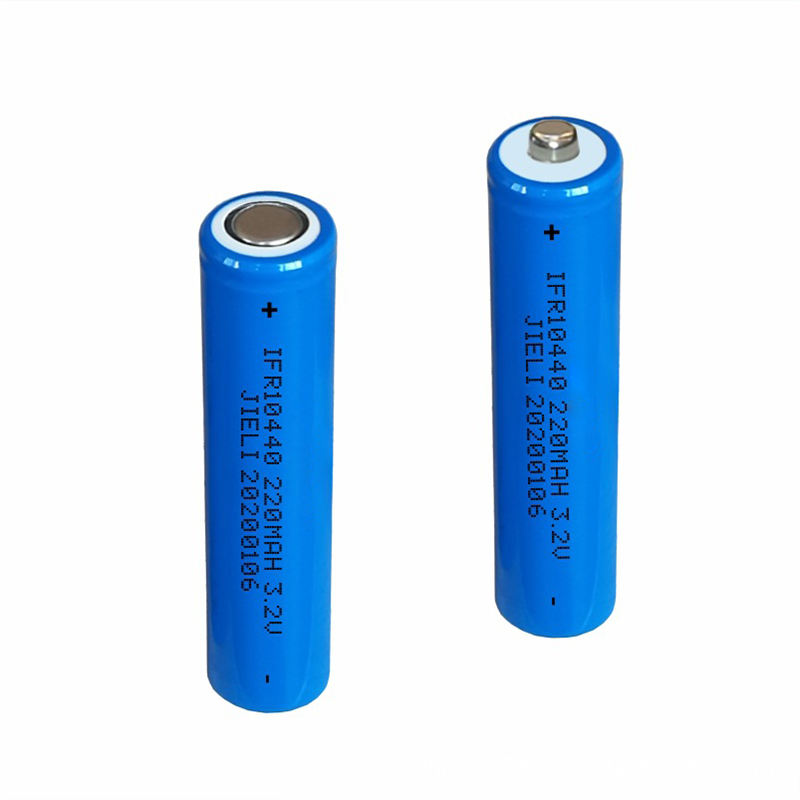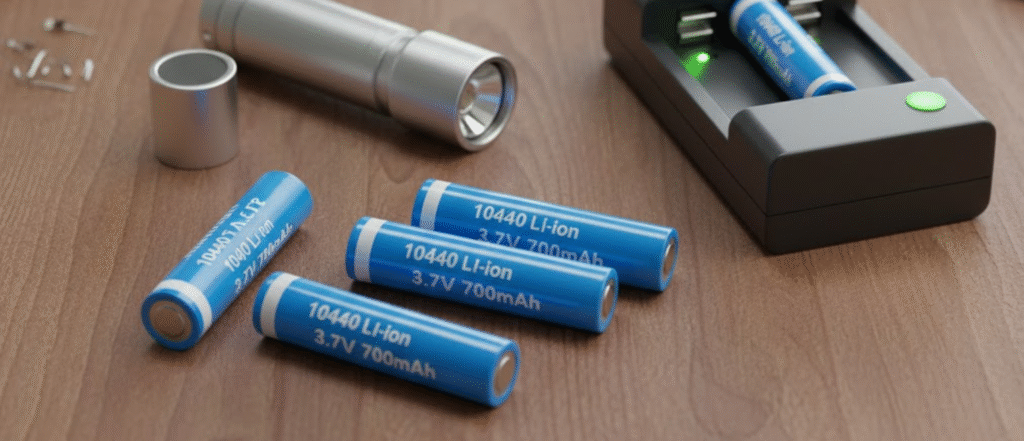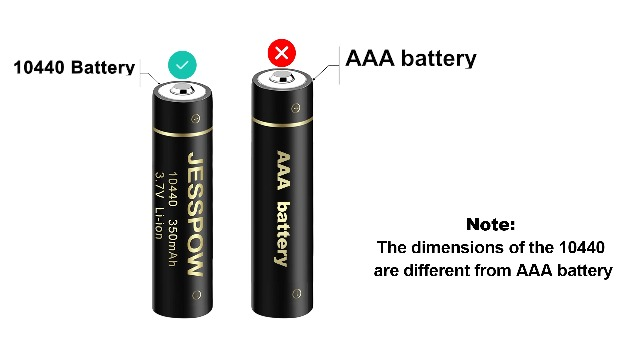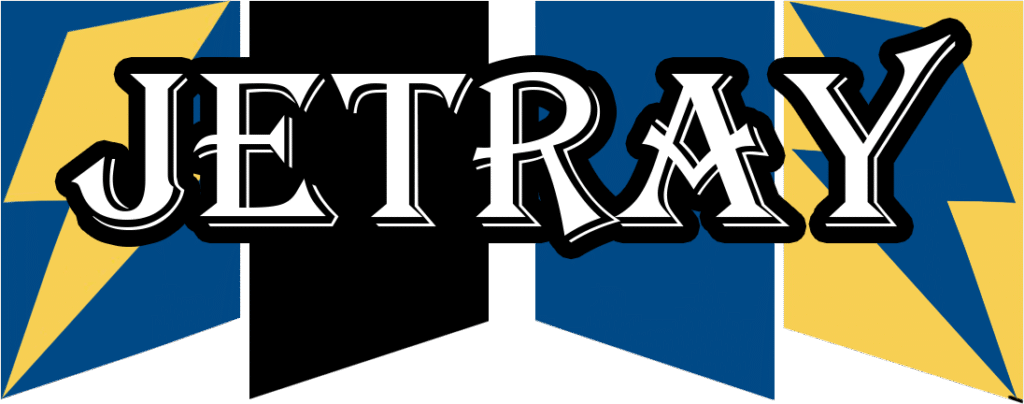If you’ve ever used a mini flashlight, laser pointer, electric toothbrush, or compact remote control, chances are you’ve encountered a 10440 battery. At first glance, it looks just like a AAA battery — but inside, it’s a very different beast. The 10440 is a rechargeable lithium-ion battery that delivers much higher voltage and energy density in the same tiny form factor.
This guide will help you understand what makes the 10440 unique, how to use it safely, and whether it’s the right choice for your device. Let’s dive in.
What Is a 10440 Battery?
The term “10440” comes from the IEC naming convention — the first two digits indicate the diameter (10 mm), the next two the length (44 mm), and the final “0” shows it’s a cylindrical cell.

That means a 10440 battery is essentially a 10×44 mm lithium-ion rechargeable cell, roughly the same size as a AAA battery but with a nominal voltage of 3.6 – 3.7 V, far higher than a standard AAA’s 1.5 V.
Basic specifications:
Chemistry: Lithium-ion (LiCoO₂, NMC, or similar)
Nominal voltage: 3.6–3.7 V
Full charge voltage: 4.2 V
Typical capacity: 300–600 mAh
Weight: About 10 g
Shape: Cylindrical (AAA size)
Because of its compact size and high output, it’s often found in portable lighting, laser devices, small medical instruments, and DIY battery packs.
Types of 10440 Batteries and How to Choose
Protected vs. Unprotected
Protected 10440: Includes a tiny PCB circuit that prevents over-charge, over-discharge, and short-circuit. Ideal for everyday users who prioritize safety.
Unprotected 10440: No built-in protection, so it can deliver higher current but requires careful monitoring — more suitable for professionals or controlled battery packs.
Flat-Top vs. Button-Top
Flat-Top: The positive terminal is flat — best for building custom battery packs.
Button-Top: The positive terminal protrudes slightly — fits most flashlights, laser pointers, and devices using single cells.
Brand Matters
Not all 10440s are equal. Reputable brands like Efest, Olight, Keeppower, EagleTac, and Ufine Battery provide more consistent performance, accurate capacity ratings, and built-in safety features. Cheap, unbranded cells may exaggerate capacity or lack protection.
Voltage, Capacity, and Performance
Nominal Voltage
Each 10440 cell delivers about 3.6–3.7 V, rising to 4.2 V when fully charged and dropping to around 2.5–3.0 V when discharged.
⚠️ Caution: This voltage is 2–3× higher than AAA batteries. Do not use a 10440 in a device designed for 1.5 V cells unless it explicitly supports lithium voltage.
Capacity
Typical capacity ranges from 300 mAh to 600 mAh. Though that may seem low, the higher voltage means total energy (Wh) remains competitive with alkaline or Ni-MH AAA batteries.
Discharge Rate
10440 batteries usually support 1–2 C continuous discharge, equivalent to about 300–1200 mA, making them perfect for low- to mid-drain devices.
Advantages and Limitations
Advantages
High energy density: Packs more energy per volume than Ni-MH or alkaline cells.
Rechargeable design: Typically supports 300–500 cycles, reducing long-term costs.
Lightweight and compact: Ideal for devices with tight space requirements.
Limitations
Voltage mismatch: Many devices expect 1.5 V — direct replacement can damage circuits.
Limited capacity: Not ideal for high-drain tools or heavy-load electronics.
Requires dedicated charger: Using the wrong charger can overheat or destroy the cell.
Applications and Typical Uses
The 10440 battery excels in small, lightweight electronics where space is limited but consistent power is needed. Common applications include:
Compact LED flashlights
Laser pointers
Electronic toothbrushes
Bluetooth headsets or earbuds
Vape pens and portable vaporizers
Medical or diagnostic devices
Remote controls and wireless sensors
However, it’s not recommended for power-hungry gadgets such as high-output flashlights, cameras, or drones — these require larger cells like 14500 or 18650.

Charging and Safety Guidelines
Use the Right Charger
Only charge 10440 batteries with a dedicated Li-ion charger that supports this small size. Never attempt to charge them with Ni-MH or Ni-Cd chargers, as this can lead to over-charging or even explosion.
Recommended brands: XTAR, Nitecore, Olight, EBL — all offer multi-slot chargers compatible with 10440 cells.
Charging Parameters
Charging voltage: 4.2 V (±0.05 V)
Charging current: 0.3–0.5 A (≈ 0.5 C rate)
Charging time: 1.5–2 hours
Avoid fast-charging or unattended overnight charging.
Safety Tips
Don’t discharge below 2.5 V — this can permanently damage the cell.
Store away from heat (keep below 60 °C / 140 °F).
Inspect the protective circuit before first use.
Never mix cells of different capacity, brand, or charge level.
Dispose of damaged or swollen cells responsibly.
Alternatives and Compatibility
10440 vs. AAA

Both share the same physical size, but 10440 delivers 3.7 V, while AAA batteries supply 1.2–1.5 V. That’s more than double the voltage — enough to fry some devices.
Only use 10440s if your product specifically states it can handle lithium-ion voltage.
Safe Replacement Options
If you simply want rechargeable AAA-sized batteries without voltage risk, consider:
Ni-MH AAA batteries (1.2 V): Safe for any AAA-compatible device.
LiFePO₄ AAA batteries (3.2 V): Offer slightly higher voltage but much safer than 3.7 V Li-ion.
Comparison Table
| Model | Size (mm) | Voltage (V) | Capacity (mAh) | Typical Use |
|---|---|---|---|---|
| 10440 | 10 × 44 | 3.7 | 350–600 | Small rechargeable lithium battery |
| 14500 | 14 × 50 | 3.7 | 700–1000 | Mid-sized flashlights, sensors |
| 16340 | 16 × 34 | 3.7 | 650–1000 | High-power flashlights |
| AAA | 10 × 44 | 1.2–1.5 | 900–1200 | Common consumer electronics |
If your device allows slightly larger cells, 14500 batteries offer a strong upgrade path with higher capacity and longer runtime.
Summary and Recommendations
The 10440 battery is a compact powerhouse — a small cell that delivers impressive voltage and energy for its size. It’s a perfect match for low-to-moderate-drain gadgets that demand rechargeable convenience in a slim design.
Before buying, remember to:
Check if your device supports 3.7 V cells.
Choose protected versions for safe operation.
Use a reliable Li-ion charger designed for 10440 batteries.
When handled correctly, a 10440 can deliver excellent performance for hundreds of cycles — making it a cost-effective, eco-friendly, and practical energy solution for compact electronics.




